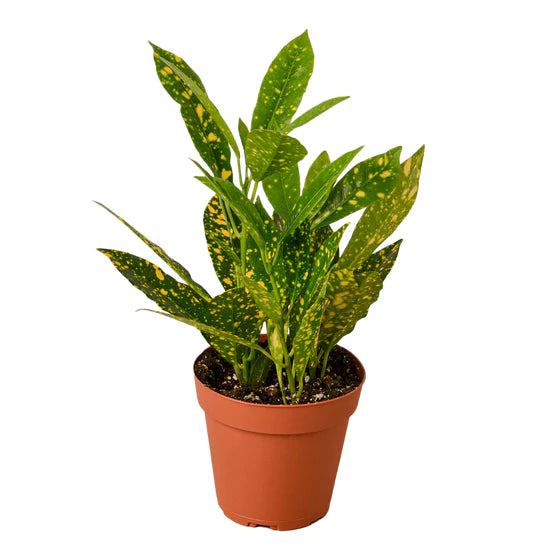Croton 'Gold Dust' Medium
Couldn't load pickup availability
-
Appearance: The Gold Dust variety is characterized by its green leaves sprinkled liberally with bright yellow spots, giving it the appearance of being dusted with gold. The leaves are typically broad and leathery.
-
Native Habitat: Crotons are native to the tropical regions of Southeast Asia and Oceania, particularly in Indonesia and Malaysia.
-
Growth Habits: Crotons are perennial evergreen shrubs. They can grow quite tall in their natural habitats but are typically kept smaller when grown as houseplants.
-
Light Requirements: Croton 'Gold Dust' thrives in bright, indirect light. Direct sunlight might scorch the leaves, but too little light might diminish the vibrancy of the leaf colors.
-
Watering: These plants prefer consistently moist soil, but it's important not to let the plant sit in water. Good drainage is crucial to prevent root rot.
-
Temperature: Crotons prefer warm and humid conditions, mimicking their tropical origins. They're sensitive to cold drafts and temperatures below 60°F (15°C).
-
Soil: A well-draining potting mix, often formulated for tropical plants or cacti/succulents, is recommended.
-
Fertilization: During the growing season (spring and summer), Crotons benefit from regular feeding with a balanced liquid fertilizer.
-
Pruning: To maintain the desired shape or size, you can prune the plant. Pruning can also encourage a bushier growth habit.
-
Toxicity: Croton 'Gold Dust', like other Croton varieties, contains a milky sap that can be irritating to the skin and eyes. If ingested, it can be toxic to humans and pets. It's a good idea to handle the plant with care and keep it away from pets and children.
-
Propagation: Croton can be propagated from stem cuttings. It's advised to wear gloves when handling cuttings due to the plant's sap.
-
Pest Issues: They can occasionally suffer from pests like spider mites, especially when the air is too dry. Regularly check the undersides of leaves and treat any infestations early.
Croton 'Gold Dust' is a fantastic choice for adding a splash of color to indoor or outdoor spaces (in suitable climates). However, the plant does need a bit of attention and care to keep it looking its best, especially when it comes to providing the right light and humidity conditions.


Croton 'Gold Dust' Medium

